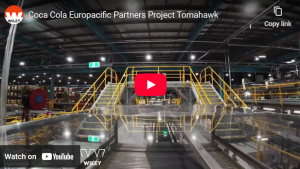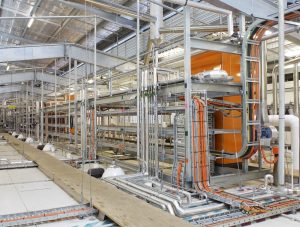
- Industry Type: Industrial Manufacturing, Warehousing, Food Processing
- Author: Steve Christie
- Service Area: Advice, Design
- Date: 27 Jul 2011
DESIGNED ON DEMAND
The art of designing a food factory is constantly evolving to meet the demands of shifting markets, suppliers, retailers and staff. The layout decisions you make today will have far reaching affects and could severely restrict your ability to adapt to future implications. Careful consideration of the diverse variables facing your factory’s evolution will ensure a factory design which is future proof.
The 80s and 90s were decades defined by productivity drives, quality systems and enterprise bargaining. Combine these with the significant impact of energy crises, environmental concerns and energy management systems and you can see how the design of food factories has been drastically shifted to meet demand.
For the most part, we can see these were years of manufacturers desperately reacting to the rapid changes inflicted on them by the industry at large. As the industry continues to develop and shift into this new millennium we can already see the impact of these new issues on modern factory layout.
NEW CHALLANGES
Retailer private label growth, the carbon tax, transport congestion, and work force changes are some of the dominant forces affecting plant layouts in the current food industry. Though you need to design your factory to meet your short term needs, it is imperative that you consider your future requirements and design accordingly.
The growth in private labels is forcing food manufacturers to place more emphasis on new product development in order to differentiate from the house brands. This requires highly flexible factories which can accommodate these new processes and shorter runs as the product range becomes divided by these new offerings. Tremendous pressure also begins to mount as these manufacturers must achieve a balance of margin saving, efficient production while the overall factory layout must retain flexibility as its focal attribute.
A carbon tax will place a real financial benefit on energy reductions for lighting, heating, cooling and transport. Design elements that reduce travel distances and utilise natural light, improved building materials and utilities will play a major role in achieving a lower energy footprint. Achieving a reduction in wastage can be the largest contributor to reducing your energy footprint and this can be achieved with the improved processes reflected in your intelligently designed factory layout.
Transport to and from factories is becoming an issue as local infrastructure struggles to cope with increased traffic flows. Minimising the number of trips required will become more important and there will be growing pressure to use larger vehicles such as B-doubles. This has a major impact on site layout as these vehicles are difficult to reverse and require significantly more space to manoeuvre and park than semi-trailers. The inclusion of B-double access is far easier at the factory layout stage than after the factory has been built.
PUTTING THE ‘MAN’ BACK INTO MANUFACTURE
“A determined soul will do more with a rusty monkey wrench than a loafer will accomplish with all the tools in a machine shop.” Robert Hughes (Australian Critic, Born: July 28, 1938)
Workforce changes are probably the single most significant influence on modern factory design with Generation X and Y now playing an important role in the future of food manufacture.
Generation X (1965 to 1980) has a different outlook to the workplace when compared to the workaholic baby boomers which preceded them. They are independent, resourceful, and self-sufficient. They value freedom and responsibility while holding disdain for structured work and authority. They are less committed to the employer as many have watched their parents lose long held, seemingly invulnerable jobs.
Generation Y (1980 – present) values their family over work. They are confident, ambitious and achievement oriented. They have been raised on a diet of team sports and play groups and as a result crave attention with a strong desire for feedback and inclusion. They are constantly connected to their peers through social media, texts and have an appetite for forums and personal opinion.
The traditional factory environment will not suit these generations of workers. They will not be satisfied with, or productive in, the isolation of operating a single machine along a production line. They will be seeking enriched, purposeful jobs with flexibility, responsibility and control over their situation. This all comes at a time when we are at full employment and staff retention has become a critical element in food manufacturing operations.
The food factory of the future will be designed around the workers and their needs rather than the equipment focused approach of the past.
The starting point is to determine the management structures for your factory. Will your factory be run by groups or teams? Will the teams be function or line based? Will they be self-managed or have a fixed management structure? There are no right or wrong answers to these questions however they need to be carefully considered before a layout can be started.
Groups are best suited to scalable tasks where the performance and experience of each individual helps achieve a good result, for example forklift drivers servicing the factory. Teams are best employed when the collective experience of all the members is used to achieve a better result than as individuals, for example a team could be responsible for the operation of bottling. There are many publications available that discuss the virtues of teams. Lean manufacturing has been developed around the team approach and Gen X and Y are more suited to the self-managed team environment.
A factory layout based on self-managed teams is designed using sophisticated sociotechnical systems to merge the social aspects important to the functioning of the team with the equipment required for the tasks. Gen X and Y value responsibility and inclusion so they should be involved in the design of their work areas and their place within it.
The design of the manufacturing cell is critical for a successful team. An effective manufacturing cell positions the operators close together to achieve a functional social environment. This can often be achieved by incorporating a “U” shaped production line layout. The equipment surrounds the team and allows all team members good access to assist each other if required. This is preferable to the traditional straight production line with machines placed for optimum equipment functionality. The operators are isolated beside machines with little regard to the location of other team members.
Break out areas are required for the team to discuss the operation of the line. Amenities and lunch areas should be of a high standard to encourage interaction between all teams to help combat “silo- thinking”. Often high level walkways are added to enable visitors and team members to view the operations and increase contact between teams. The design goal of all areas should be to encourage interaction and active discussion of team performance.
The modern factory produces more with less people and our dependence on the few that are left has increased. When designing your factory layouts you must consider your people’s needs and wants and customise your design to meet them. Use the flexibility of modern production equipment to achieve the social outcomes necessary to satisfy and retain today’s workers.
It can be difficult to ensure you have taken everything into consideration as you plan your latest design layout. The essence of successful work environments is in achieving a balance of people, place and purpose. With that in mind, begin your plans by firstly understanding the placement, movement and interaction of your people and then match this to the placement, movement and interaction of your product and machinery.
Achieving this balance of people, place and purpose is the key to a considered, well designed modern factory—one that will take your business well into the future.
About the author
Steve Christie is the Director of Process Engineering at Wiley and can be contacted on 1300 385 988 or email connect@wiley.com.au.
This article was published in Food & Drink Business Magazine.
Download to read full article
To read this document you will need Adobe Reader


